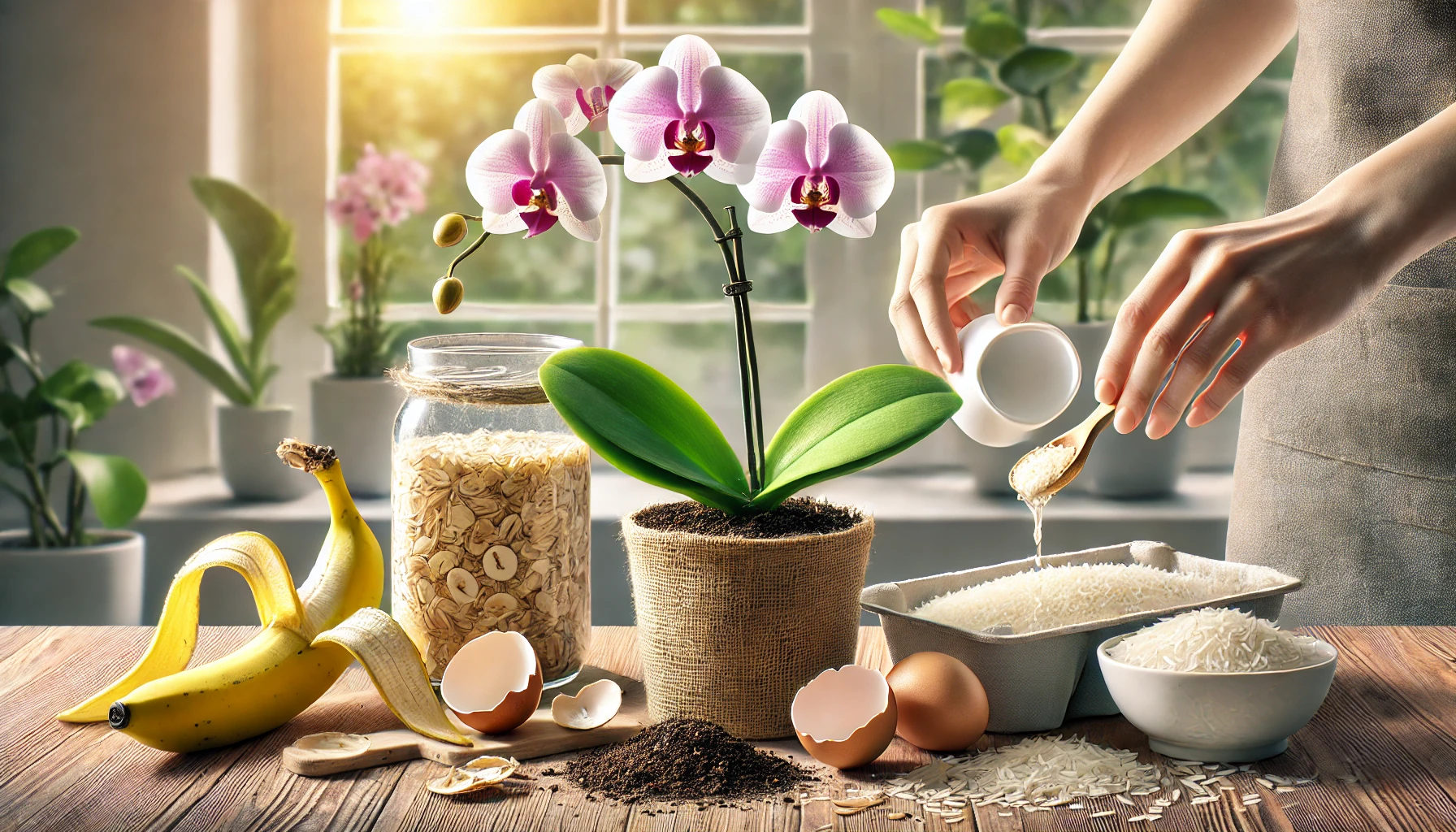Fertilizing orchids is essential for their growth and blooming, but commercial fertilizers can sometimes be expensive or contain unnecessary chemicals. Luckily, homemade fertilizers can provide the necessary nutrients while being more natural and budget-friendly. Understanding which organic materials work best and how to apply them correctly will help your orchids thrive with strong roots, lush leaves, and vibrant flowers.
🌱 Why Do Orchids Need Fertilizer?
Unlike regular plants that grow in soil rich in nutrients, most orchids are epiphytes or semi-terrestrial, meaning they attach to trees or rocks in the wild. They absorb nutrients from rain, decaying leaves, and surrounding organic matter. When grown in pots, orchids rely entirely on their caregivers for nutrients.
✔ What Fertilizer Does for Orchids:
- Encourages strong root growth for better water absorption.
- Supports healthy leaf development to produce energy.
- Boosts flower production for longer-lasting, more frequent blooms.
- Prevents nutrient deficiencies that cause yellowing leaves or weak stems.
💡 Without proper fertilization, orchids may survive, but they won’t thrive or bloom as often.
🌿 Best Natural Ingredients for Homemade Orchid Fertilizer
There are many organic materials that contain the essential nutrients orchids need, such as nitrogen (N), phosphorus (P), and potassium (K).
✔ Banana Peel Tea (Rich in Potassium and Phosphorus)
- Boosts flower production and root strength.
- Contains natural enzymes that help orchids absorb nutrients.
- How to Use:
- Chop one banana peel and soak it in 1 liter (4 cups) of water overnight.
- Strain and use the liquid to water orchids once every two weeks.
✔ Eggshell Water (High in Calcium and Magnesium)
- Supports cell structure and strong root growth.
- Prevents weak, floppy leaves caused by calcium deficiency.
- How to Use:
- Crush 5 eggshells and boil them in 1 liter (4 cups) of water for 10 minutes.
- Let cool, strain, and use the water to mist or water orchids once a month.
✔ Rice Water (Mild Fertilizer with Vitamins and Minerals)
- Contains amino acids and natural starches that boost orchid growth.
- Provides a gentle, balanced nutrient mix.
- How to Use:
- After washing rice, save the cloudy water instead of throwing it away.
- Use it to water orchids once every two weeks.
✔ Used Tea Leaves or Tea Water (Rich in Nitrogen)
- Helps green leaves grow strong and vibrant.
- Works as a mild organic fertilizer.
- How to Use:
- Let a used tea bag soak in a liter of water for 1–2 hours.
- Use it to lightly mist or water orchids once every two weeks.
✔ Aloe Vera Solution (Boosts Immunity and Root Growth)
- Contains natural enzymes that fight infections.
- Helps stimulate new root and flower spike growth.
- How to Use:
- Blend one aloe vera leaf with a cup of water and strain.
- Use the liquid to spray the leaves or water the roots once a month.
💡 Each of these natural fertilizers provides different benefits—rotating them will keep your orchid well-nourished!
💧 How to Apply Homemade Fertilizers to Orchids
The way you apply fertilizer is just as important as the type of fertilizer you use. Over-fertilizing can cause salt buildup and root damage, while under-fertilizing may result in slow growth.
✔ Best Practices for Applying Homemade Fertilizer:
- Always dilute natural fertilizers to prevent overfeeding.
- Water the orchid with plain water first before applying fertilizer—this prevents root burn.
- Apply fertilizer only during active growth (spring and summer).
- Reduce fertilization in fall and winter when orchids enter dormancy.
- Use a spray bottle to apply fertilizers lightly to leaves and roots.
💡 A good rule is “weekly, weakly”—feed orchids once a week with a very diluted fertilizer solution.
🚫 What NOT to Use as Orchid Fertilizer
Not all organic materials are safe for orchids. Some homemade fertilizers may be too acidic, too strong, or cause mold and bacteria buildup.
❌ Coffee Grounds – Too acidic for orchids and can encourage fungal growth.
❌ Milk or Dairy Products – Can cause bacterial infections in the potting mix.
❌ Raw Fruit or Vegetable Scraps – May attract pests and create mold.
❌ Animal Manure – Too strong for delicate orchid roots.
💡 Stick to mild, plant-based fertilizers that mimic the nutrients orchids get in nature.
🌸 Signs That Your Orchid Needs Fertilizer
If an orchid is not getting enough nutrients, it will show visible signs of deficiency. Knowing what to look for can help you adjust its care.
✔ Yellowing Leaves – May indicate a nitrogen or magnesium deficiency.
✔ Slow or No Growth – Suggests lack of phosphorus or potassium.
✔ Weak Flower Spikes – Orchid may need more potassium for stronger blooms.
✔ Wrinkled or Limp Leaves – Can be a sign of poor nutrient absorption or dehydration.
💡 Regular feeding with natural fertilizers will help prevent these issues and keep your orchid healthy.
🛡 Final Tips for Using Homemade Fertilizer on Orchids
✔ Choose mild, organic ingredients that provide essential nutrients.
✔ Rotate different natural fertilizers to give a balanced mix of nutrients.
✔ Always dilute homemade fertilizers to avoid harming roots.
✔ Water orchids before fertilizing to prevent burns.
✔ Observe plant health—adjust feeding if leaves or roots show signs of stress.
By using the right homemade fertilizers and applying them correctly, you can keep your orchids strong, healthy, and full of beautiful blooms year after year! 🌸✨
